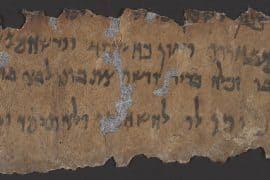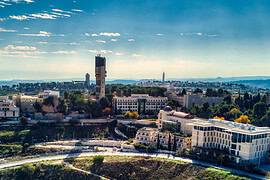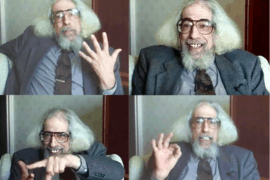The “Tomb of the Shroud,” that was discovered and investigated in 2000 by Shimon Gibson, Boaz Zissu, and me, with a team of our UNC Charlotte students in the summer of 2000, continues to yield up many scientific secrets about life and death in Jerusalem in the time of Jesus. I related the basic story of the exciting discovery of this freshly robbed tomb in the Introduction to my book The Jesus Dynasty in 2006 and Shimon Gibson has recently provided a more thorough analysis in his new book, The Final Days of Jesus: The Archaeological Evidence (HarperOne, 2009). We published a preliminary report in the journal Hadashot Arkheologiyot (vol. 111: 2000, pp. 70-72, figs. 138-139) and a major monograph is planned for 2018.
Various aspects of the research are beginning to appear in scientific journals. Although the burial shroud itself continues to receive great public interest (see The Daily Mail), other aspects of research on this tomb are quite notable.
DNA profiles were done on all the bones in the tomb, so far as we know for the first time in an ancient tomb in Jerusalem from the Herodian period and comparisons are now being made with DNA results from the Talpiot “Jesus Family” tomb. We recently noticed that the mtDNA tests for two sets of two of the individuals each from this tomb are a match for the results of individuals from the Talpiot Jesus family tomb–-one set matches the skeletal materials taken from both the Yeshua and the Mariamene ossuaries, while the other set matches remains taken from the Marya ossuary. We are now doing further tests including on the hair itself.
We also have the only substantial example of male hair from the period (lice free, cut reasonably short, and well groomed), see “The Only Ancient Jewish Male Hair Ever Found.”

Most important, the shrouded male in the tomb has leprosy (Hansen’s Disease)–the earliest case of ever found in the Holy Land or elsewhere in the Levant. The significance of the latter discovery is a major contribution to our understanding of ancient disease and has recently been published in the current issue of the Public Library of Science Journal. Here is an overview from the Jerusalem Post from December 2009 that reports on the tomb and its important contents, highlighting the leprosy finding.
Remains in tomb near Old City show first known case of leprosy
Dec. 15, 2009Judy Siegel-Itzkovich , THE JERUSALEM POST
DNA taken from the shrouded remains of a man discovered in a tomb next to the Old City of Jerusalem shows him to be the first human proven to have suffered from leprosy, according to Hebrew University researchers and North American and British collaborators. They published their findings in the December 16 issue of the PLoS One – the US Public Library of Science journal.Prof. Mark Spigelman and Prof. Charles Greenblatt of the Sanford F. Kuvin Center for the Study of Infectious and Tropical Diseases at HU in Jerusalem, along with Prof. Carney Matheson and Kim Vernon of Lakehead University in Canada, Prof. Azriel Gorski of New Haven University and Dr. Helen Donoghue of University College London performed the molecular investigation. The archeological excavation was led by Prof. Shimon Gibson, Dr. Boaz Zissu and Prof. James Tabor on behalf of the Israel Antiquities Authority and the University of North Carolina at Charlotte.
The burial cave, known as the Tomb of the Shroud, is located in the lower Hinnom Valley near the Jaffa Gate and part of a first century CE cemetery known as Akeldama, or “Field of Blood” (mentioned in the Book of Matthew 27:3-8, and Acts 1:19 in the Christian Bible). It is located adjacent to the spot where Judas is said to have committed suicide.
The tomb of the shrouded man is also located next to the tomb of Annas, the high priest (6 CE to 15 CE), who was the father-in-law of Caiaphas, the high priest who betrayed Jesus to the Romans. It is thus believed that this shrouded man was either a priest or a member of the aristocracy. Gibson suggests that the view from the tomb would have looked directly toward the Second Temple.
The tomb is very unusual because it is clear that this man, whose remains are dated by radiocarbon methods to 1 CE to 50 CE, did not receive a subsequent burial. Secondary burials were common practice at the time, when the bones were removed after a year and placed in an ossuary (a bone box made of stone). In this case, however, the entrance to this part of the tomb was completely sealed with plaster. Spigelman believes this is because the man had suffered from leprosy and died of tuberculosis, as DNA of both diseases was found in his bones.
Historically, disfiguring diseases such as leprosy led to the sufferer being ostracized from their community. However, a number of indications – the location and size of the tomb, the type of textiles used as shroud wrappings, and the clean state of the hair – suggest that the shrouded individual was a fairly affluent member of Jerusalem society, and that tuberculosis and leprosy may have crossed social boundaries at that time.
This is also the first time fragments of a burial shroud have been found from the time of Jesus in Jerusalem. The shroud is very different to that of the Turin Shroud, until now assumed to be the one that was used to wrap the body of Jesus after his crucifixion. Unlike the complex weave of the Turin Shroud, this is made up of a simple two-way weave, as textile historian Dr. Orit Shamir was able to demonstrate.
Based on the assumption that this is representative of a typical burial shroud widely used at the time of Jesus, the researchers conclude that the Turin Shroud did not originate from Jesus-era Jerusalem.
The excavation also found a clump of the shrouded man’s hair, which had been ritually cut before he was buried. These are both unique discoveries because organic remains are only rarely preserved in the Jerusalem area owing to the soil’s high humidity levels.
Spigelman and Greenblatt state that the origins and development of leprosy are largely obscure. Leprosy in the Jewish Bible may well refer to skin diseases such as psoriasis. The leprosy known to us today was thought to have originated in India and brought over via bacteria to the Near East and Mediterranean countries during the Hellenistic period. The results from the First Century Tomb of the Shroud fill a vital gap in our knowledge of this disease, they said.
Furthermore, the new research has shown that molecular pathology clearly adds a new dimension to the archeological exploration of disease in ancient times and a better understanding of the evolution, geographic distribution and epidemiology of disease and social health in antiquity.
The co-infection of both leprosy and tuberculosis here and in 30 percent of DNA remains in Israel and Europe from the ancient and modern period provided evidence for the postulate that the medieval plague of leprosy was eliminated by an increased level of tuberculosis in Europe as the area urbanized.









Comments are closed.